As the demand for developing software or enhancing existing technology tools with advanced solutions increases, many businesses decide to outsource app development. According to Statista, the global application development outsourcing market is expected to grow from $118.17 billion in 2024 to $124.07 billion by 2029, demonstrating steady growth over the course of a decade.
Showing solid and stable demand, businesses operating in eCommerce, manufacturing, supply chain management, or finance sectors increasingly seek outsourcing services that cover IT expertise gaps, especially in such domains as AI/ML, data science, and advanced analytics. They also look for cost savings on IT while maintaining quality. With numerous companies offering app development outsourcing, it’s crucial to know how to find the right vendor and seal a solid partnership with them. This article provides actionable and proven tips to do it.
The Growing Adoption of Application Development Outsourcing
Several economic, technological, and strategic factors drive the growing trends for outsourcing application development. Businesses opt for partnerships with tech vendors in order to navigate the complex nature of modern software development.
One of the main reasons to outsource application development remains cost optimization. According to Deloitte’s 2024 Global Outsourcing Survey, 57% of executives cited cost reduction as a key reason for outsourcing IT services. This happens due to unstable market conditions, where companies need to show maximum productivity yet still reduce software development expenses.
The same Deloitte’s survey shows that businesses lack highly specialized talent, especially in such areas as AI/ML. 83% of surveyed executives expect that third-party vendors will bring AI expertise when hired. This is not a surprising number as advanced technologies evolve extremely fast nowadays. While industry-specific businesses focus on IT expertise and adherence to regulations in their domain, they do not have time to grasp completely new technological innovations. From this stems another reason for outsourced app development – strategic shift towards core competencies. This shift allows organizations to boost efficiency in their primary business areas while relying on tech vendors for IT services.
Last but not least, remote work has become a regular part of work life and more and more businesses are switching to global collaboration because of it. According to Statista, 91% of employees reported that they preferred either a fully or an almost remote work in 2023. Even regarding the fact that major tech companies ask their employees to return to office in 2025, the Harvard Business Review report highlights significant resistance among employees: 60% believe the cost of commuting outweighs the benefits, 67% feel going to the office requires more effort than before the pandemic, and 73% say it has become more expensive. Given these concerns, most companies are likely to adapt to employee preferences, and remote or at least hybrid work is here to stay.
The Cutting-Edge Benefits of Offshore App Development
Apart from cutting costs, filling skill gaps, and creating beneficial work conditions, businesses have many more reasons to consider when hiring offshore app development teams.

- Access to Region-Specific Expertise: Outsourced development allows tapping into specialized knowledge of local markets, regulations, and user preferences. For example, US-based fintech startups can partner with Japanese tech firms to ensure local payment gateway integrations.
- Exposure to Cutting-Edge Technologies: Partnering with outsourced app developers provides access to the latest programming languages, frameworks, and emerging technologies, accelerating innovation. For instance, European companies can collaborate with Ukrainian tech vendors for AI/ML development services since this county has especially strong education programs in computer science and data engineering.
- Risk Mitigation Through Shared Accountability: Distributing development efforts across multiple teams reduces dependency on a single in-house unit and minimizes risks connected to disrupting projects. For example, a company needs to launch a new high-priority product by a specific deadline to seize a market opportunity or outpace a competitor, so stakeholders task the outsourced team with pivoting resources and focus.
- Better Crisis Resilience: Outsourced application development enhances business continuity by leveraging teams in different time zones. For example, For example, a US-based company located in Florida may experience a hurricane and need to shut down operations; an outsourced team can back up the project and ensure continuity.
Making Offshore Mobile App Development a Success: 6 Proven Tips
Outsourcing app development is a multifaceted process that requires a thorough understanding of the tech market in different locations, skills and rates typical for specific countries, culture and holidays in a given region, and more. Below are tested and proven pieces of advice to navigate this process effectively.
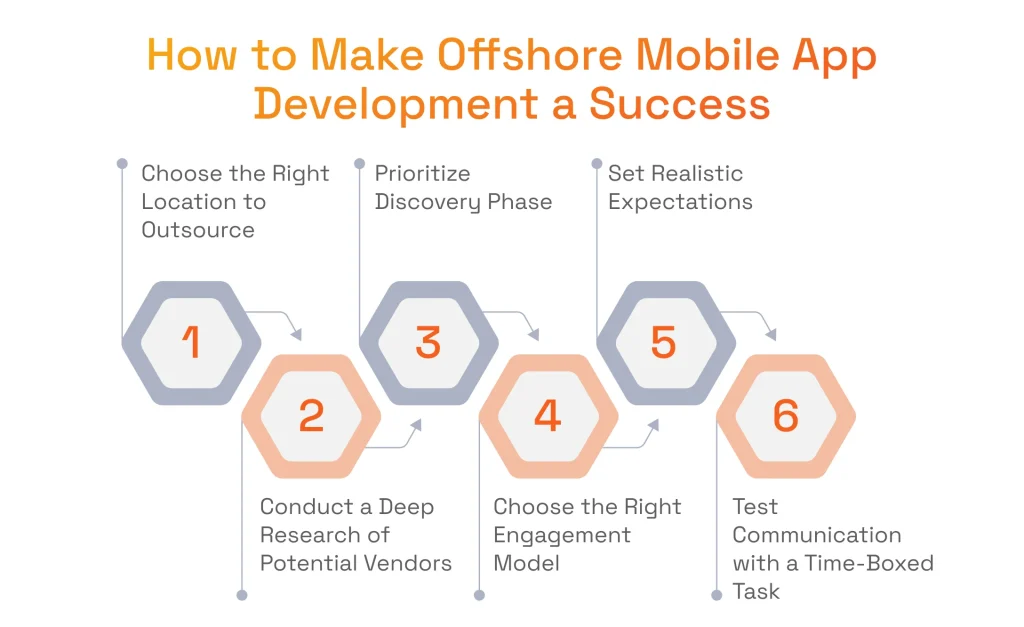
Tip #1: Choose the Right Location to Outsource Mobile App Development
Distributed software development is a popular decision for many businesses today. Therefore, selecting the optimal destination to outsource mobile app development is a critical move that can significantly impact the success of the project. From skillset availability to cost-effectiveness, several key factors must be carefully considered to ensure a successful collaboration.
Latin America (LATAM)
Latin America can be a preferred choice for clients from North America due to its cultural and time zone alignment. These factors contribute to seamless collaboration, effective communication, and timely project management.
Tech Talent Availability
With a tech talent pool nearing 2 million professionals, Latin America stands out as a promising destination for app development outsourcing. Statista notes that Argentina and Brazil lead the Latin American region with the largest information technology market. Here are some important data from the report:
- Argentina’s software market was valued at approximately $650.8 million, with projections indicating growth beyond $915 million by 2028.
- Brazil’s software industry was expected to expand by more than $3 billion between 2023 and 2028.
Main Skills
Developers in LATAM possess expertise in web and mobile application development. The top five most popular programming languages in Latin America are HTML, CSS, JavaScript, Python, and Java. Additionally, the most utilized frameworks include React, Express, Angular, Spring Boot, and Next.js.
Rates
As for the Latin American app developers rates, the majority of tech companies represented on Clutch charge $25-49 per hour. This makes the LATAM region a compelling option for app development outsourcing, particularly for North America, where the average software development hourly rate is $50 – $150.
Asia
Despite significant cultural and time zone differences between Asia and the US or Western Europe, the IT market in Asia remains a top choice for outsourcing app development due to its extensive talent pool and attractive rates. What’s more, Asian developers are known for being highly adaptable to client preferences.
Tech Talent Availability
According to Research and Markets’ report, the Asia Pacific custom software development market is projected to experience a CAGR of 20.9% from 2022 to 2028. China, Japan, and India emerge as the leading countries in this region for outsourcing app development companies.
- China led the Asia Pacific custom software development market by country in 2021, reaching a market value of $7.1 billion by 2028.
- Japan is experiencing a CAGR of 20.1% during the period of 2022-2028.
- The Indian market is expected to demonstrate a CAGR of 21.6% during the same timeframe.
Main Skills
Asian developers are known for their proficiency in software development, QA/testing, and IT infrastructure. They are often a preferred choice for mobile app development outsourcing. The most popular programming languages in the Asia Pacific region include Java, JavaScript, Python, C++, and PHP.
Rates
On average, Asian tech companies listed on Clutch have the outsourcing app development cost range of $50 – $99.
Western Europe
Western Europe is an excellent choice to find skilled developers for projects. While time zone alignment with the United States may pose challenges, companies within the region can find outsourcing desktop, web, or mobile app developers from neighboring countries quite convenient. Cultural similarities and a strong emphasis on professionalism make Western Europe well-suited for both US-based and European projects.
Tech Talent Availability
According to Statista, the app outsourcing market in Europe is expected to have a drastic growth in the coming years. It is projected to reach an estimated $39.97 billion in market value by 2029. Here are some other facts about the region:
- The European IT outsourcing market’s projected average spending per employee is expected to hit $460.30 by 2025.
- Germany leads the European application development outsource market due to its robust infrastructure offerings and skilled workforce.
Main Skills
Developers in Western Europe possess expertise in niche areas like AI, IoT, and blockchain. According to Enterprise App Statistics, the programming languages commonly used by software engineers in these countries are Python, Java, JavaScript, C#, R, and C/C++.
Rates
According to Clutch, the average rate range for software developers in Western Europe is $50-$99. This relatively high figure reflects the region’s higher cost of living and skilled labor.
Eastern Europe
Eastern Europe’s software development appeal to enterprises from North America and Western Europe extends beyond its robust tech ecosystem and encompasses the diverse industry expertise of the local workforce. With numerous vendors handling projects across several sectors like financial services, IT, business services, healthcare, and eCommerce, the region offers specialized offshore software development and industry compliance in addition to cultural affinities and significant overlap in working hours.
Tech Talent Availability
According to a Statista report, revenue in the software market in Eastern Europe is expected to reach $9.86 billion in 2025, with the majority of revenue being generated in the United States. Ukraine, Poland, and Romania are among the popular destinations for desktop, web, and mobile development outsourcing.
- Enterprise Software is the leading force in this market segment, anticipated to generate a market revenue of US$4.44 billion by 2025.
- Poland‘s outsourcing market is experiencing explosive growth, fueled by a highly skilled workforce and compelling price competitiveness, drawing in global companies.
- Ukraine’s IT sector saw a notable surge, contributing $6 billion to the country’s export earnings during the initial ten months of 2022, reflecting a significant 10% increase compared to 2021.
Main Skills
Eastern European developers are proficient in multiple programming languages, including JavaScript, PHP, Java, Python, and .Net.
Rates
According to Clutch, the typical outsource app development cost in the region ranges between $50 and $99. Such rates remain competitive compared to Western Europe, striking a balance between quality and cost-effectiveness.
We are proof that collaborating with international clients can yield productive and streamlined outcomes. As an illustration, an Israeli petcare company asked us to outsource mobile application development for computer-vision powered API creation. Through this initiative, we facilitated the building of a resilient neural network, enabling rapid image analysis and minimizing manual intervention. Additionally, we introduced an AI-supported remote veterinary service as a premium feature, thereby generating an extra revenue stream for our client.
Tip #2: Conduct a Deep Research of a Mobile App Outsourcing Company
In addition to technical proficiency and location, it’s crucial to ensure that the chosen vendor has expertise in a specific niche, be it FinTech, eCommerce, or manufacturing. With domain knowledge, desktop, web and mobile app development agencies know how to address industry-related challenges in the product development process and deliver tailored, high-quality solutions. Plus, expertise in specific industries makes it easier to comply with regulatory requirements.
Below are factors to consider when selecting an application development outsourcing company with expertise in a particular domain.
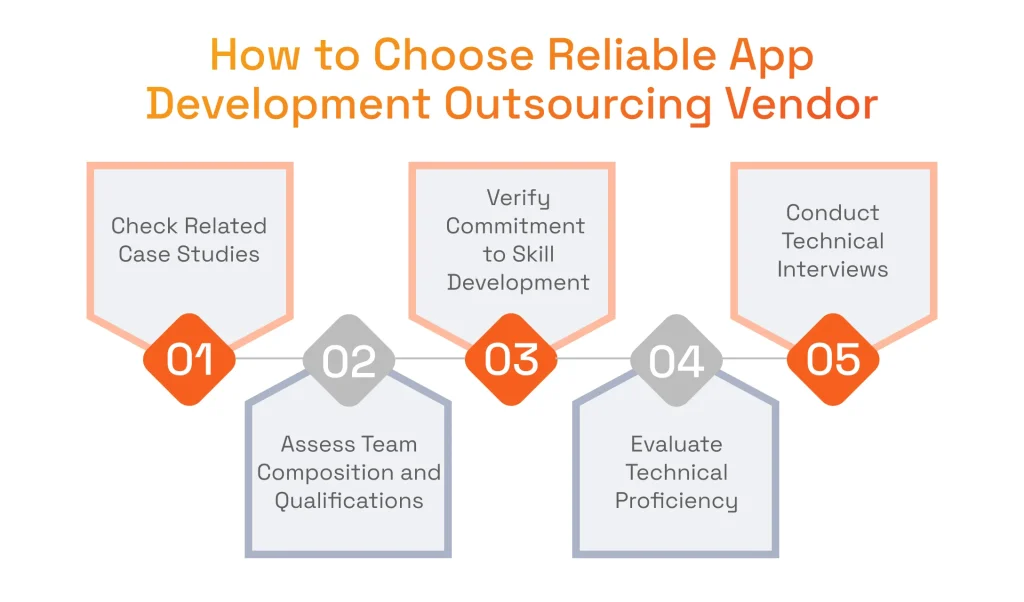
Check Related Case Studies
To be able to harness valuable industry-specific expertise, businesses must narrow the search to software development outsourcing companies with at least 5+ years’ experience in delivering solutions for their industry. To find such vendors, it is recommended to check out candidates’ related case studies.
When choosing an app development company to outsource app development to, it’s also crucial to consider whether they can still have the expertise they showcase in their portfolio. This means ensuring that the skilled individuals who worked on similar projects in the past are still employed by the company. Sometimes, a company might showcase successful projects in their portfolio, but the people who actually developed those apps may no longer work there.
Assess Team Composition and Qualifications
Kicking off the app development project with a full-fledged team with a diverse array of experts, including designers, developers, architects, data scientists, QA engineers, means there won’t be additional hiring issues during the execution. That also means no release delays. To ensure all members have the right skills, it is important to scrutinize their qualifications, certifications, and experience levels upfront.
For example, when selecting a tech vendor to outsource mobile app development for payment software, businesses need to look for developers proficient in Java/Kotlin (for Android) or Swift/Objective-C (for iOS) for mobile coding and experienced in integrating payment APIs. Another factor to consider is certifications like CISSP when looking for security experts and . experience in designing scalable infrastructures, when hiring back-end professionals.
Verify Commitment to Skill Development
When outsourcing app developers, their commitment to continuous improvement means that the planned project will have all the required expertise even if the new advancements appear during the actual project execution. For this, businesses need to inquire about professionals’ dedication to ongoing training and skill development initiatives and look for tangible evidence of their efforts (participation in industry conferences, workshops, online courses certifications).
For instance, when outsourcing mobile application development, businesses should examine developers’ recent projects and technology stack to see if they adopt modern practices. To add to that, conducting technical interviews and investigating the vendor’s internal knowledge-sharing culture allows validating how they handle changing requirements.
Evaluate Technical Proficiency
To gauge a potential vendor’s technical knowledgebase and skills, it is recommended to request access to sample code, demos, or prototypes they have developed. This provides the chance to evaluate their capabilities firsthand and assess their adherence to best practices within the niche technology. Reviewing their portfolio of past projects, particularly those similar to the ones required for development, provides further insight into their expertise and the quality of their work.
Suppose the business is planning to outsource mobile app development of a banking software. In this case, asking to see a prototype of a mobile banking application they’ve worked on is a reasonable thing to do. Thus, it becomes possible to check the execution of such features as account management, fund transfers, bill payments, and security measures like two-factor authentication and understand whether the similar feature development will be beneficial for a required project.
Conduct Technical Interviews or Assessments
If a business wants to be fully aware of what their vendor can bring to the project, engaging in discussions on specific technical challenges is unavoidable. During such technical interviews, it is possible to evaluate the potential partner team’s problem-solving skills, ability to communicate technical concepts clearly, and their approach to handling complex scenarios.
For example, when a company decides to outsource mobile app development, the evaluation of a vendor’s expertise for a document management software development can include solving the specific challenges like data security, collaboration features, and version control.
Additionally, when considering hiring project managers with the mobile app development team, the company needs to evaluate their proficiency in Scrum and Agile methodologies. This involves assessing their understanding of Agile principles, such as iterative development, collaboration, and continuous improvement, as well as their ability to effectively implement Scrum practices, including sprint planning, daily stand-ups, and sprint retrospectives.
Interested in learning how to hire a dedicated development team?
Discover all the essential details in our comprehensive guide!
Tip #3: Prioritize Discovery Phase During App Development Outsource
The discovery phase of an outsourced project lays down the essential groundwork upon which the entire project’s success hinges. We have previously discussed the significance of this phase in our discussion of 6 tips to assist CTOs in outsourcing product development. And again, we want to highlight that with a close collaboration between stakeholders and app development companies, it is possible to establish a comprehensive roadmap, outlining the project scope, goals, and potential challenges.

Oleksadr Boyko
Delivery Director at SPD Technology
“The discovery stage is about seizing a crucial opportunity to anticipate and address potential risks, align expectations, and foster a shared understanding among all stakeholders. This initial phase sets the tone for the entire app development process, ensuring that everyone is on the same page.”
To be confident in the choice of the team, here is a checklist outlining how businesses can confirm that the potential vendor is right for the project:
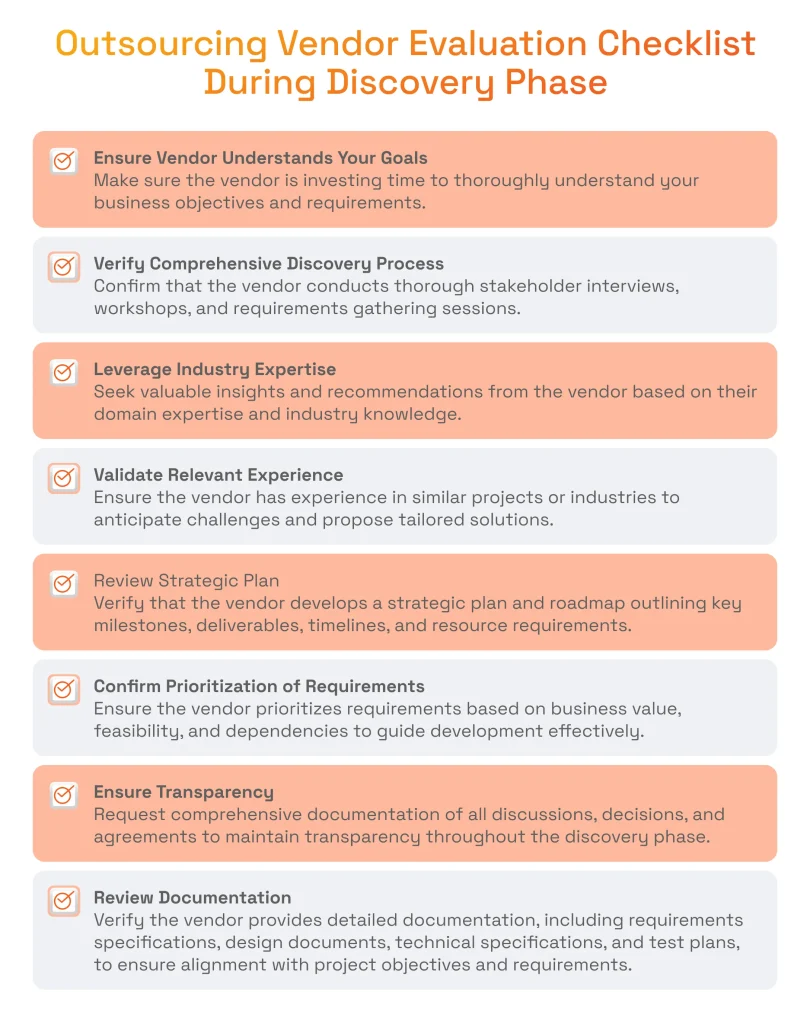
Tip #4: Go for the Right Engagement Model When Outsourcing App Development
Choosing the appropriate engagement model in software development makes sure that the collaboration between the client and the outsourcing team is productive, cost-efficient, and value-driven. To choose the right model, it is important to consider such factors as project duration, expertise required, optimal costs, and some other factors described below.
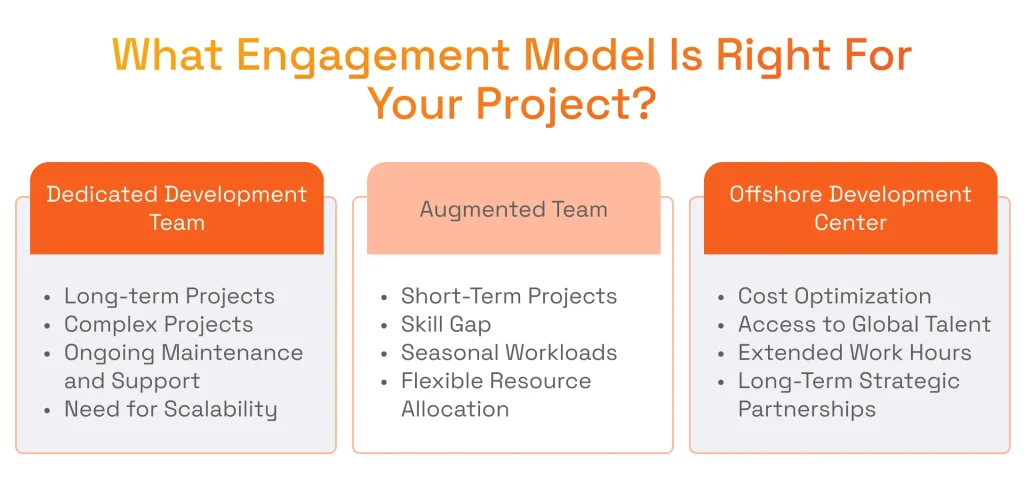
Dedicated Development Team
The dedicated model is the most suitable when the business wants their IT specialists to focus solely on a specific project. In such a way, a company gains access to a talent pool, while still having control over dedicated development team management. This means that the company can scale their application development outsource team up or down as needed, ensuring they have the right resources at the right time to meet project deadlines and adapt to new requirements.
The dedicated team model is suitable for:
Long-term Projects: By hiring a dedicated app development team to work exclusively on projects, companies ensure their teams become deeply familiar with the project’s intricacies to maintain sustained focus and deliver consistent progress.
Complex Projects: The dedicated app development team model allows businesses to assemble a team capable of consistently contributing to the project while also addressing emerging challenges. The members of the team are skilled to tackle atypical issues with creativity.
Ongoing Maintenance and Support: By engaging a dedicated team, companies ensure timely response to maintenance needs and ongoing support. The team remains readily available to address any issues that may arise.
Need for Scalability: Whether ramping up for a new project initiative or downsizing after project completion, businesses can adjust the team size once the project demands it without being tied to long-term commitments.
Augmented Team
When a project that already has an allocated team requires additional enhancements, IT staff augmentation can help in-house teams to extend their expertise or speed up progress with external resources. Rather than hiring more mobile app developers to work in-house, businesses can opt for temporary or contract specialists to address specific skill deficiencies, fulfill project requirements, or manage heightened workloads.
Staff augmentation suits:
- Short-Term Projects: Businesses can quickly augment their in-house development team with external specialists to address project requirements without the need for long-term commitments.
- Skill Gap: With staff augmentation, businesses can access the expertise needed to enhance their project capabilities eliminating the need for extensive training or recruitment efforts.
- Seasonal Workloads: By outsourcing mobile developers during peak periods, businesses can maintain productivity, meet project deadlines, and deliver quality outcomes without overburdening their internal team.
- Flexible Resource Allocation: Companies can scale their workforce up or down based on project requirements without incurring significant overhead costs associated with hiring full-time employees.
For more than ten years, we have partnered with Mogami, a US-based Fintech company, on the development of a personal finance management application. SPD Technology provided mobile app development outsourcing services to build a robust and feature-packed iOS and Android application, which has garnered a loyal user base. Our successful integration of the app with the MX solution has paved the way for its adoption by banking institutions. This strategic initiative positions our client for promising opportunities to effectively market the solution in the Financial Services sector.
Offshore Development Center (ODC)
Setting up an offshore mobile app development comes up as a reasonable option, when businesses want to have full control over the progress of their projects and workloads of their offshore mobile app developers. This center functions as a deliberate expansion of the internal development capabilities, offering mobile application development outsourcing with cost-efficient and resourceful manpower and infrastructure.
Placing app development offshore allows businesses to benefit from:
- Cost Optimization: By opting for offshore mobile application development, companies can access skilled professionals at competitive rates, which reduces development costs and still help maintain high-quality standards.
- Access to Global Talent: By setting up an ODC, companies can outsource app developers with the right expertise no matter if they live remote from headquarters.
- Extended Work Hours: Offshore mobile app development means having a center in a location with a different time zone, which offers the possibility of continuous development or maintenance work outside regular business hours.
- Long-Term Strategic Partnerships: Collaboration with ODC enables businesses to align with their offshore partner’s expertise and capabilities and work towards a common goal.
Seeking efficient ways to set up an offshore development center?
Discover all the intricacies in our article!
Tip #5: Set Realistic Expectations for App Development Outsourcing
Setting a realistic budget and reasonable timeline means aligning the potential of an outsourced team with the realistic capabilities of technology involved in the project and goals of stakeholders. When both the client and the team understand each other’s performance capacity, budget constraints, and project scope, they can plan effectively and address potential challenges early on.
Below are some common factors to consider when hiring software developers for a startup or an established product.
Account for Time Zone Differences
The biggest concern with time zone differences is delays in communication. When immediate responses to queries or issues are not feasible, the project release can be significantly postponed. This is a typical concern for web and mobile app development outsourcing companies for India or Europe when they are hired by a US-based client.
We usually overcome this problem by establishing clear communication protocols that outline acceptable response times for urgent and non-urgent matters. This guides us in scheduling critical meetings and setting realistic response expectations.
Be Prepared for Knowledge Transfer
When engaging with a web or mobile app outsourcing company, it’s easy to assume they will jump in fully prepared. However, without proper onboarding, developers may lack insights into your specific domain, branding standards, or project objectives. As a result, misunderstandings, rework, and extended timelines can hinder the project development.
Guided by our two decades of experience, we know that thorough onboarding with clients is a must. We usually ask businesses to share the documentation about their business model, target audience, and technical infrastructure. Our team also prioritizes regular meetings with the client, especially at the beginning of the project. In this manner, we can grasp crucial details, from coding standards to design guidelines, hear feedback and adjust our design, development and communication approaches accordingly.
Consider Post-Launch Expectations
Once your application goes live, outsourcing app maintenance comes as the next necessary step. This will help cover bug fixes and updates to preserve and improve the quality of the app and adjust it to the ever-changing market demands. It is an important factor to have in mind even before the project starts since it requires planning of the budget and developer availability.
When onboarding on the project, we always ask our client whether they need support from our team. If yes, we agree on a support model (hourly, retainer-based, or included as part of the original contract) and schedule periodic check-ins to review performance metrics for strategizing future enhancements.
Expect a Learning Curve
The nature of web or mobile development outsourcing demands extra time for diving into the industry, branding, or user profile details with each new project. This can create concerns for clients as this learning period can slow initial progress, as the team familiarizes itself with your unique requirements.
When we onboard the project, our team includes learning stages in the project timelines. Further, we set incremental milestones to measure progress rather than expecting instant results. Based on these practices, we set KPIs and agree to them with the client beforehand. In this manner, the client receives reporting with met KPIs and our team works in a transparent manner, benefiting from a clearly defined natural adaptation period.

Oleksadr Boyko
Delivery Director at SPD Technology
“If you don’t anticipate this ramp-up phase, you might become impatient with early project outputs or timelines. This might even undermine the relationship with the vendor.”
Tip #6: Test Communication with a Time-Boxed Task for Outsourced App Developers
Assessing how an outsourced team handles a small, time-sensitive assignment reveals their communication style, responsiveness, and ability to follow instructions. Businesses can evaluate these soft skills by creating the following environment.
Creating a Mini-Project
Before starting the major project, it is preferable to select a small task that reflects an actual feature or challenge. This task may be focused on building a login screen or creating a simplified data visualization and have a detailed briefing that lays out functionality requirements, design expectations, and performance benchmarks. In this manner, businesses can focus on seeing how effectively the outsourced team interprets instructions, manages constraints, and sticks to specified guidelines without the complications of a full-scale development effort.
Setting a Strict Deadline
The task mentioned in the previous paragraph needs to come with a timeframe of one or two days to simulate the urgency of real production environments. This allows client-companies to observe how the team responds to tight deadlines and understand whether the potential partner team can adapt to last-minute requests, balance speed with accuracy, and deliver iterative feedback.
Monitoring Communication
Throughout the task, businesses need to pay close attention to the team’s responsiveness when clarifying requirements, sharing progress updates, and acting on any changes you propose. Additional attention should be paid to channels they use for communication (Slack, email, or a project management tool like Jira) because this indicates how effectively they communicate across different time zones. In this way, businesses can check the promptness, clarity, and attention to detail of a potential outsourced company or team, which highlights their collaborative style and organizational discipline.
Evaluating Output & Process
When reviewing the finished product, businesses must consider not only its quality and adherence to specifications but also how well the team navigated any obstacles or changing information during development. For this, it is important to look at how they managed the timeline, documented their work, and remained proactive in problem-solving. These factors collectively indicate whether they can adapt to your needs, maintain transparency, and deliver consistently in a full-scale project setting.
Possible Risks and Challenges of Offshore Mobile App Development
When looking for best practices of how to outsource app development, companies will certainly find this one: you have to know what difficulties to anticipate to allocate efforts and sometimes even budget for their resolution. Below we list what challenges we typically face when companies engage with us for mobile or web app development outsourcing.
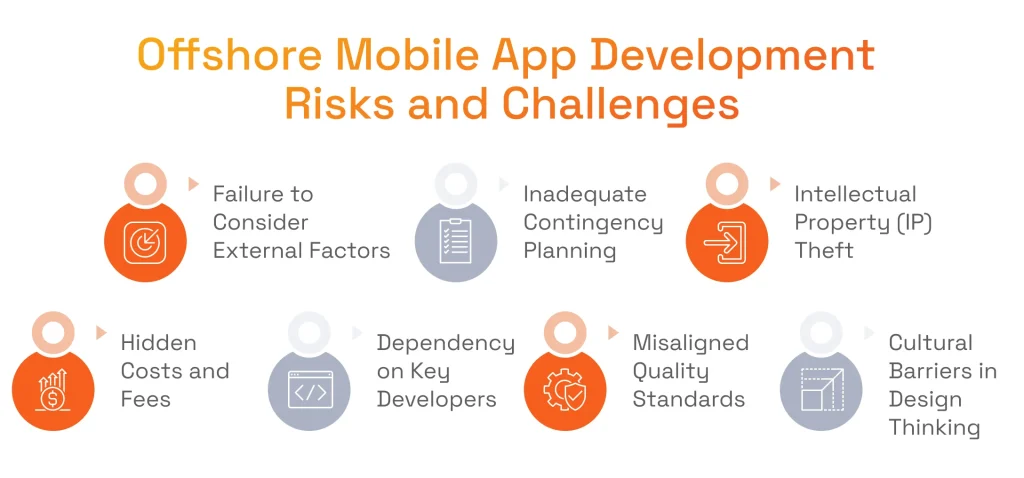
Failure to Consider External Factors
When working with clients who operate in the financial sector, we often encounter changes in regulations. Sure thing, the development process needs to be adjusted to those changes: new issues must be addressed and new workflows need to be studied. Additional headaches in any industry can also be market changes, such as increased or low demand, which require infrastructure changes, or third-party dependencies, which may require adjustment to custom APIs we develop.
We try to anticipate those issues and plan our work accordingly. For that, our team follows relevant industry trends, market dynamics, and stays tuned to the regulatory landscape. In this manner, we can forecast with high probability what efforts we will need to make on the project. In addition to this, we also always calculate how much time we need to address unpredicted risks to include them into the timeline and prevent failing to deliver by the deadline.
Inadequate Contingency Planning for Outsourcing App
When setting app development offshore, businesses may fail to allocate sufficient contingency reserves for unforeseen events, delays, or changes. This can happen due to an overemphasis on cutting costs, which often leads to unrealistic budgeting and narrowly estimated timelines. In some cases, this can create a domino effect where teams are forced to cut corners or deprioritize critical tasks once the inevitable surprises arise.
We prioritize including buffers to eliminate this risk. Those are typically 10–20% added to the project budgets to handle cost overruns, delays, and unexpected scope changes. To know where potentially these buffers will be needed, our team conducts thorough risk assessment alongside both in-house and offshore teams, identifying potential pitfalls such as communication gaps, technology incompatibilities, or regulatory hurdles.
Intellectual Property (IP) Theft
Many businesses put huge creative efforts to come up with market-revolutionizing, competitive software. It is their highest priority to protect that. However, when collaborating with overseas teams, trade secrets, proprietary algorithms, and critical data may be shared across different jurisdictions with varying legal protections. This lack of enforceable legislation can make businesses worry about their IP theft.
When engaging in app development outsource, we sign non-disclosure agreements (NDAs) that outline ownership rights, confidentiality obligations, and legal recourse in the event of an IP violation. NDAs explain how all the parties can share the project information as well as access limits on certain pieces of data, which brings our clients peace in terms of protecting valuable assets.
The choice to outsource mobile application development is often dictated by cost-effectiveness, yet many hidden costs may create significant bottlenecks later. Some of our clients shared their stories about how other vendors could increase development prices due to currency fluctuations, hourly rate discrepancies, additional charges for revisions, and unexpected scope changes.
Our company helps clients to avoid surprise expenses and conducts contract revision sessions. We ask our clients to pay particular attention to clear statements of work, payment terms, and potential extra charges. Plus, when some of our potential clients show worries about expenses, we offer to sign fixed-price or milestone-based agreements to make costs predictable and manageable.
Dependency on Key Offshore Mobile App Developers
From our experience, reliance on a small group of skilled outsourced developers or even a single engineer can introduce considerable risks. When key specialists become unavailable, the whole process may stop. In this case, critical knowledge might be lost, the progress could slow down, deadlines could be missed, and the budget might increase indefinitely.
To avoid such developer dependency when opting for web, iOS, or Android app development outsourcing, the project key stakeholders must foster knowledge sharing. For this, we typically ensure that the documentation is in place, and architectures and codes are shared across the development team.
Misaligned Quality Standards of Outsourced App Development
Companies often encounter misaligned quality standards when outsourcing mobile app development, as different teams may interpret the nature of “high quality” definition differently. Discrepancies might involve coding conventions, design aesthetics, performance criteria, or testing methodologies.
We help our clients-to-be to establish clear, measurable quality benchmarks at the outset of the project. For this, we define coding guidelines, performance metrics design guidelines, and user acceptance testing criteria and clearly add them to our partnership contracts.
This helps us to harmonize development standards with the clients in-house team. If we are talking about keeping up to the standards during the development process, our team does it by conducting frequent code reviews, using CI/CD pipelines, and scheduling regular feedback sessions, which are also documented in contracts.
Willing to know how legal contracts help create a shared framework that keeps everyone accountable?
Find out in our article about a service-level agreement!
Cultural Barriers in Design Thinking
When the team from the US collaborates with the team from, for example, India, each of them may bring distinct communication styles, aesthetic preferences, and assumptions about user behavior. While American designers might prioritize direct feedback and quick decision-making, their Indian counterparts may expect more context-sharing and consensus-building before moving forward.
Once we deal with clients who may have a significantly different design vision, we pay particular attention to collaborating workshops that allow sharing design inspirations. Thus, it becomes possible to agree on the overall design vision, as well as share user research data that reflects the perspectives and preferences of the end customers. With such an approach, we can make designers and developers stay on the same page and, therefore, ensure that outsourcing of mobile application development is as smooth as possible.
Choosing the Right Partner to Outsource Mobile App Development
Outsourcing mobile development means finding a partner that will bring the right skills, necessary knowledge, and unique vision to the project. With the help of a technology vendor, companies can put their project execution on a whole new level as their partner:
- Ensures High-Quality Deliverables: The tech vendor leverages proven methodologies, rigorous testing, and best practices to maintain exceptional standards throughout the development process.
- Reduces the Risk of Project Delays: By quickly allocating resources and adapting to unexpected challenges, an experienced development team helps keep timelines on track.
- Offers Expertise in Relevant Technologies: Specialized professionals know how to deliver with AI/ML, data analytics, BI, and edge computing solutions to ensure innovative software.
- Delivers Long-Term Support: A tech vendor provides ongoing maintenance, updates, and troubleshooting to keep the app performing optimally after launch.
- Mitigates Financial Risks: Professional services prioritize transparent pricing models and detailed project estimates to avoid hidden costs for web and mobile app outsourcing.
- Ensures Compliance with Regulations: Skilled partners stay current on legal requirements and make sure apps meet applicable standards and guidelines.
- Reduces Management Overhead: Vendors handle daily coordination and operational tasks, which allows in-house teams to focus on strategic goals.
Consider SPD Technology as Your Mobile Development Outsourcing Vendor
With almost two decades of experience in outsourcing our services to clients in the US and Western Europe, SPD Technology has become a solid player in the market. Our team knows how to make cooperation with clients seamless, professional, and up to higher standards. With us, businesses get access to:
- Proven Experience in Complex Projects: We draw on over 19 years of delivering robust solutions for intricate requirements and ensure high-quality outcomes under demanding conditions.
- Dedicated Cross-Functional Teams: Our specialized development, design, QA, and project management professionals collaborate seamlessly to accelerate project success.
- Expertise in the Latest Technologies: We polish our expertise in custom AI development, data science, edge computing, and other advancement to help businesses stay competitive in the evolving market.
- Support for Strategic Innovation: By combining technical expertise with consultative guidance, we empower organizations to push boundaries and spur transformative growth.
- Demonstrated Track Record of Resilience: Our proven ability to adapt to shifting priorities and market changes ensures stable, long-term application development outsource project outcomes.
Mobile App Development Offshore: SPD Technology’s Success Stories
Our team successfully delivered several projects for clients who set up mobile app development offshore.
Outsourced iOS App Development for AI-Driven Wellness Analysis App
A US-based B2C healthcare company outsourced iPhone app development services to create the app for health and beauty monitoring that encompasses advanced, AI and computer vision powered features.
Business Challenge
The client needed the application that consolidated multiple health indicators, provided real-time personalized insights, and accurately analyzed users’ facial characteristics to deliver skincare advice. Their ultimate goal was to present complex medical data in a user-friendly format, connect users with high-quality medical professionals, and offer an all-in-one app experience that monitors health, recommends treatments, and tracks aging effects.
SPD Technology’s Approach
The client decided to outsource iOS developers and two ML engineers to leverage advanced AI and ML models trained on a carefully curated medical dataset under strict data-quality reviews, which enabled high-accuracy detection of facial imperfections and reliable aging estimations. Complementing this analysis, our team integrated a Retrieval-Augmented Generation (RAG) chatbot with a tailored Large Language Model (LLM) to explain results in plain language and provide users with relevant healthcare and skincare recommendations. Finally, the entire functionality was delivered via an iOS application that unifies device data, ML-driven insights, and user engagement.
Value Delivered
Our team successfully delivered a market-ready iOS solution that achieved:
- 95% accuracy across its AI/ML models;
- 90% precision in detecting facial imperfections.
Outsource Mobile Development: Ticket Marketplace for Seattle Landmark Space Needle
Space Needle, a famous observation tower in Seattle, sought to boost visitor engagement by improving a mobile app and a CMS that would enhance their onsite experience.
Business Challenge
The client asked us to create a CMS and the app that leverages ticketing information from a third-party vendor, as well as build features for delivering digital photos directly to users, and implement functionality like QR code scanning and 360° panoramic views, and AR.
SPD Technology’s Approach
Starting from scratch, we took charge of developing both the mobile application and a custom CMS. The team tackled React Native’s early-stage limitations by devising creative approaches to the 360° panorama feature, where hundreds of photos had to be stitched together to recreate an immersive cityscape. Integrating AR was another challenge, requiring a native bridge in Swift to connect React Native with Unity and deliver an engaging AR experience.
Value Delivered
We launched the project on schedule, coinciding with the busy tourist season and ensuring maximum app usage and guest satisfaction. The app was a success with:
- 1,000,000+ downloads across iOS and Android;
- GuestX Integration, granting user behavior metadata collection for further improvements.
Conclusion
Software development outsourcing is a valuable approach to save costs, benefit from exceptional expertise, and ensure flexibility on IT projects. For those considering desktop, web, or mobile app development outsourcing, it is important to choose the right outsourcing location, conduct a deep research on a potential partner, prioritize the discovery stage, choose a suitable engagement model, and set realistic expectations.
To outsource app development, you also need to consider challenges that can await, particularly failure to consider external factors, inadequate contingency planning, IP theft, hidden costs, misaligned quality standards, dependency on key developers, and cultural differences in design vision. However, when working with a trusted vendor, it becomes possible to minimize or even eliminate these risks. With all of these considerations in mind, SPD Technology is here to assist you every step of the way. Don’t hesitate to reach out to us if you require any assistance or further guidance.
FAQ
How to Outsource App Development?
When outsourcing app development, start by clearly defining project requirements, including goals, features, and functionalities. Next, research reputable software development companies within a preferred location, focusing on their experience, niche expertise, and track record. Choose an engagement model for collaboration with the outsourced team. Lastly, remember to assess and plan for potential risks by developing a contingency plan for the project.
How Much Does it Cost to Outsource App Development?
The cost of outsourcing app development varies based on factors such as project complexity, development platform, geographic location of the outsourcing partner, team composition, and project timeline. To determine the exact outsourced app development cost, discuss specific requirements with potential partners and request detailed project estimates.





